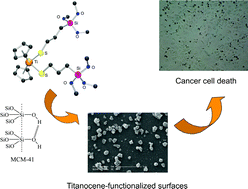Improvement of cytotoxicity of titanocene-functionalized mesoporous materials by the increase of the titanium content†
Abstract
The reaction of [Ti(η5-C5H5)2Cl2] (1), with

* Corresponding authors
a
Institut für Chemie, Martin-Luther-Universität Halle-Wittenberg, Kurt-Mothes-Straße 2, Halle, Germany
E-mail:
goran.kaluderovic@chemie.uni-halle.de
b
Department of Chemistry, Institute of Chemistry, Technology and Metallurgy, University of Belgrade, Studentski trg 14, Belgrade, Serbia
E-mail:
goran@chem.bg.ac.rs
c
Departamento de Química Inorgánica y Analítica, E.S.C.E.T., Universidad Rey Juan Carlos, Móstoles, Madrid, Spain
E-mail:
santiago.gomez@urjc.es, damian.perez@urjc.es
Fax: 34 914888143
Tel: 34 914888527
d Institute of Oncology and Radiology of Serbia, Belgrade, Serbia
The reaction of [Ti(η5-C5H5)2Cl2] (1), with

 Please wait while we load your content...
Something went wrong. Try again?
Please wait while we load your content...
Something went wrong. Try again?
G. N. Kaluđerović, D. Pérez-Quintanilla, Ž. Žižak, Z. D. Juranić and S. Gómez-Ruiz, Dalton Trans., 2010, 39, 2597 DOI: 10.1039/B920051G
To request permission to reproduce material from this article, please go to the Copyright Clearance Center request page.
If you are an author contributing to an RSC publication, you do not need to request permission provided correct acknowledgement is given.
If you are the author of this article, you do not need to request permission to reproduce figures and diagrams provided correct acknowledgement is given. If you want to reproduce the whole article in a third-party publication (excluding your thesis/dissertation for which permission is not required) please go to the Copyright Clearance Center request page.
Read more about how to correctly acknowledge RSC content.
 Fetching data from CrossRef.
Fetching data from CrossRef.
This may take some time to load.
Loading related content
